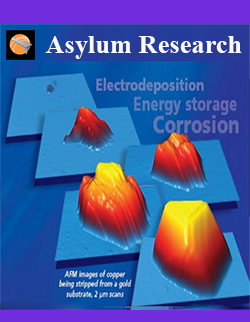 |
See it yourselfNow scheduling demos!
MRS Fall Meeting, booth #510
Nov 29-Dec 1 | Boston, MA |
The Highest Performance Electrochemical AFM (EC-AFM)
The Cypher ES with EC Cell: See electrochemical reactions in real time. Compatible with a wide range of materials.
The Electrochemistry Cell for the Asylum Research Cypher ES atomic force microscope is the premier solution for in situ AFM characterization of electrochemical processes. Its simple modular design provides great versatility and compatibility with a wide range of materials. Best of all, it is based on the Cypher ES AFM— the world’s highest resolution, fast scanning AFM with superior environmental control and ease of use for maximum productivity.
- Fully sealed EC cell with uniquely designed cantilever holder and liquid cup for easy imaging in fluid
- Compatible with most common and cutting-edge electrolytes and electrode materials
- Simple to clean and assemble, even with gloves
- Optional heating and cooling stages allow investigation of electrochemical thermodynamics
- Glovebox option provides the ultimate environmental control with no performance compromises

Time series of AFM images showing the electrochemical stripping of copper from a gold electrode in an acidic 0.1 M copper sulfate solution. Imaged in tapping mode using blueDrive photothermal excitation. Graph: Voltammogram showing reductive deposition and oxidative stripping corresponding to the process shown in the images above.
Applications for the EC Cell
Electrodeposition • Energy Storage • Corrosion
- Characterizing energy storage materials under bias, such as battery electrodes, membranes and solution-electrode interfaces
- Electrodeposition and stripping of metals
- Investigating kinetics of corrosion
- Monitoring morphology over time of electrode-attached biocatalysts, microorganisms, and other biophysical research
- Nucleation and growth of nanoparticles
See it yourself



